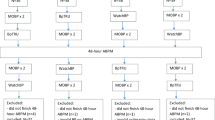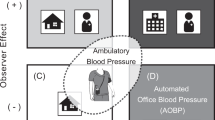Abstract
Accuracy in blood pressure measurement is critical for proper hypertension diagnosis and treatment in clinical practice. Automated office blood pressure (AOBP) can simplify the measurement process, reducing human error and minimizing the white-coat effect in the unattended mode. The aim of this study was to compare AOBP, both unattended and nurse attended, with conventional office and out-of-office blood pressure measurement techniques. Four different methods of blood pressure measurement were performed in a cohort of hypertensive patients: conventional office blood pressure (OBP), unattended automated office blood pressure (uAOBP), nurse attended automated office blood pressure (nAOBP), and home blood pressure monitoring (HBPM). uAOBP and nAOBP were conducted with the same rigorous standardized procedure. We enrolled 118 consecutive patients. nAOBP values were slightly higher than uAOBP ones (respectively 132.8/73.3 ± 19.4/12.9 and 129.2/71.1 ± 19.0/12.3 mmHg), even if the difference was influenced by order of execution of AOBP measurement. nAOBP was significantly lower than HBPM and OBP (mean values 135.2/80.9 ± 16.6/8.1 and 140.9/84.6 ± 18.7/10.8 mmHg, respectively). AOBP, either attended or unattended, provides lower values than conventional OBP. uAOBP and nAOBP values showed small differences, even if they are not completely interchangeable. This evidence reflects a lower white-coat effect, even in nurse attended technique, but is also due to a lower measurement error through the application of a rigorous standardized protocol.
This is a preview of subscription content, access via your institution
Access options
Subscribe to this journal
Receive 12 digital issues and online access to articles
$119.00 per year
only $9.92 per issue
Buy this article
- Purchase on Springer Link
- Instant access to full article PDF
Prices may be subject to local taxes which are calculated during checkout




Similar content being viewed by others
References
Myers MG. Eliminating the human factor in office blood pressure measurement. J Clin Hypertens. 2014;16:83–86.
Vongpatanasin W. Accurate blood pressure in the office do it right and don’t fudge the numbers. Circulation. 2018;138:1771–3.
Myers MG. The great myth of office blood pressure measurement. J Hypertens. 2012;30:1894–8.
Padwal R, Campbell NRC, Schutte AE, Olsen MH, Delles C, Etyang A et al. Optimizing observer performance of clinic blood pressure measurement: a position statement from the Lancet Commission on Hypertension Group. Rev Panam Salud Publica/Pan Am J Public Heal. 2020;44. https://doi.org/10.26633/RPSP.2020.88.
Parati G, Omboni S, Bilo G. Why is out-of-office blood pressure measurement needed?: Home blood pressure measurements will increasingly replace ambulatory blood pressure monitoring in the diagnosis and management of hypertension. Hypertension. 2009;54:181–6.
Williams B, Mancia G, Spiering W, Rosei EA, Azizi M, Burnier M, et al. 2018 ESC/ESH guidelines for thevmanagement of arterial hypertension. Eur Heart J. 2018;39:3021–104.
Johnson KC, Whelton PK, Cushman WC, Cutler JA, Evans GW, Snyder JK, et al. Blood pressure measurement in SPRINT (systolic blood pressure intervention trial). Hypertension. 2018;71:848–57.
Andreadis EA, Papademetriou V, Geladari CV, Kolyvas GN, Angelopoulos ET, Aronis KNHome. automated office, and conventional office blood pressure as predictors of cardiovascular risk. J Am Soc Hypertens. 2017;11:165–.e2.
Campbell NRC, McKay DW, Conradson H, Lonn E, Title LM, Anderson T. Automated oscillometric blood pressure versus auscultatory blood pressure as a predictor of carotid intima–medial thickness in male firefighters. J Hum Hypertens. 2007;21:588–90.
Andreadis EA, Agaliotis GD, Angelopoulos ET, Tsakanikas AP, Chaveles IA, Mousoulis GP. Automated office blood pressure and 24-h ambulatory measurements are equally associated with left ventricular mass index. Am J Hypertens. 2011;24:661–6.
Kaczorowski J, Chambers LW, Dolovich L, Paterson JM, Karwalajtys T, Gierman T, et al. Improving cardiovascular health at population level: 39 Community cluster randomised trial of Cardiovascular Health Awareness Program (CHAP). BMJ. 2011;342:422.
Andreadis EA, Thomopoulos C, Geladari CV, Papademetriou V. Attended versus unattended automated office blood pressure: a systematic review and meta-analysis. High Blood Press Cardiovasc Prev. 2019;26:293–303.
Clark CE, Horvath IA, Taylor RS, Campbell JL. Doctors record higher blood pressures than nurses: Systematic review and meta-analysis. Br J Gen Pr. 2014;64:e223–32.
Himmelfarb CRD, Commodore-Mensah Y, Hill MN. Expanding the role of nurses to improve hypertension care and control globally. Ann Glob Heal. 2016;82:243–53.
Veerman DP, De Blok K, Delemarre BJM, Van, Montfrans GA. Office, nurse, basal and ambulatory blood pressure as predictors of hypertensive target organ damage in male and female patients. J Hum Hypertens. 1996;10:9–15.
Stergiou GS, O’Brien E, Myers M, Palatini P, Parati G, Stride BP. An international initiative for accurate blood pressure measurement. J Hypertens. 2020;38:395–9.
STRIDE BP: an international initiative for accurate blood pressure measurement. Validated blood pressure monitors. https://stridebp.org/bp-monitors.
Elias MF, Goodell AL. Human errors in automated office blood pressure measurement: still room for improvement. Hypertension. 2020;77:6–15.
Pappaccogli M, Di Monaco S, Perlo E, Burrello J, D’Ascenzo F, Veglio F, et al. Comparison of automated office blood pressure with office and out-off-office measurement techniques: a systematic review and meta-analysis. Hypertension. 2019;73:481–90.
Grassi G, Seravalle G, Buzzi S, Magni L, Brambilla G, Quarti-Trevano F, et al. Muscle and skin sympathetic nerve traffic during physician and nurse blood pressure measurement. J Hypertens. 2013;31:1131–5.
Muntner P, Shimbo D, Carey RM, Charleston JB, Gaillard T, Misra S, et al. Measurement of blood pressure in humans: a scientific statement from the American heart association. Hypertension. 2019;73:E35–E66.
Myers MG, Godwin M, Dawes M, Kiss A, Tobe SW, Kaczorowski J. The conventional versus automated measurement of blood pressure in the office (CAMBO) trial: masked hypertension sub-study. J Hypertens. 2012;30:1937–41.
Drawz PE, Pajewski NM, Bates JT, Bello NA, Cushman WC, Dwyer JP, et al. Effect of intensive versus standard clinic-based. Hypertens Manag Ambul Blood Press Hypertens. 2017;69:42–50.
Acknowledgements
We thank Mrs. Roberta Pellegrini for her dedication and precious support. The study did not receive any financial assistance.
Author information
Authors and Affiliations
Corresponding author
Ethics declarations
Competing interests
The authors declare no competing interests.
Additional information
Publisher’s note Springer Nature remains neutral with regard to jurisdictional claims in published maps and institutional affiliations.
Supplementary information
Rights and permissions
About this article
Cite this article
Fanelli, E., Di Monaco, S., Pappaccogli, M. et al. Comparison of nurse attended and unattended automated office blood pressure with conventional measurement techniques in clinical practice. J Hum Hypertens 36, 833–838 (2022). https://doi.org/10.1038/s41371-021-00575-8
Received:
Revised:
Accepted:
Published:
Issue Date:
DOI: https://doi.org/10.1038/s41371-021-00575-8



